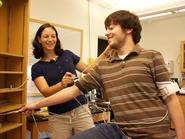
Deborah Barany '11 and Anthony Sali '10 describe motor control in a way that would remind a listener of flip-book animation. An action consists of smaller, partial movements, that when assembled together and in the right fashion, trigger the complete maneuver. Similarly, flip books rely on persistence of vision to create the illusion of fluid motion, when in reality, they are just discontinuous images stapled together.
This summer the two students are working on a project titled "Analysis and Application of the Posture-Based Movement Model (PBMM) in 3-D Space" with Professor of Psychology and Neuroscience Jonathan Vaughan. The PBMM illustrates the theory that behind any action there is a complex network of miniature actions, and a person undergoes a movement with a goal posture in mind. The entire process – even the underlying plan – is unconscious.
The three main subsets of an action are the starting posture, the goal posture, and the bounce posture. The bounce posture occurs sometime in the middle of the movement when the person needs to avoid an obstacle. By knowing the trajectory of these movements, the researchers can accurately model the specific steps that a person must take to carry out even the simplest of movements.
Barany and Sali will use what is called a "Nest of Birds" machine. It consists of sensors that run on a magnetic field to monitor where the arms, legs, and other body parts are located in space during the course of an action.
In addition to modeling their subject's actions, Barany and Sali will modify Fitt's Law, which predicts movement time based on the size of a target. Fitt's Law only applies to a two-dimensional, straight path, so the researchers are attempting to see how it applies to the 3-D world.
Sometimes having participants, who have to complete a set of tasks, work with the researchers is more difficult than it seems.
"It's sometimes kind of hard to run these kind of experiments because people don't really grasp how it relates both to psychology and what we're really doing," Barany said. "You're doing the same movement thousands of times, for an hour. We are trying to do something that's very difficult, but if we explain it to someone, we get the 'duh' [reaction].
"Obviously, it takes longer to move around an object," she laughed. "But we're also creating a mathematical model that Professor Vaughan made." They mentioned that they have to put their data into programs like Excel and MatLab using a complex set of calculations.
Sali recognizes the implications the project might have on clinical psychology. "I'm really interested in how psychology relates to our behavior," he said. "It would be interesting to see how this would relate to motor disorders down the road like Parkinson's." He plans on going to graduate school for clinical psychology, and is currently a saxophonist for many College ensembles. Barany plans to go to graduate school for cognitive neuroscience. She plays the violin in the Hamilton College Orchestra and enjoys tennis and curling.
This summer the two students are working on a project titled "Analysis and Application of the Posture-Based Movement Model (PBMM) in 3-D Space" with Professor of Psychology and Neuroscience Jonathan Vaughan. The PBMM illustrates the theory that behind any action there is a complex network of miniature actions, and a person undergoes a movement with a goal posture in mind. The entire process – even the underlying plan – is unconscious.
The three main subsets of an action are the starting posture, the goal posture, and the bounce posture. The bounce posture occurs sometime in the middle of the movement when the person needs to avoid an obstacle. By knowing the trajectory of these movements, the researchers can accurately model the specific steps that a person must take to carry out even the simplest of movements.
Barany and Sali will use what is called a "Nest of Birds" machine. It consists of sensors that run on a magnetic field to monitor where the arms, legs, and other body parts are located in space during the course of an action.
In addition to modeling their subject's actions, Barany and Sali will modify Fitt's Law, which predicts movement time based on the size of a target. Fitt's Law only applies to a two-dimensional, straight path, so the researchers are attempting to see how it applies to the 3-D world.
Sometimes having participants, who have to complete a set of tasks, work with the researchers is more difficult than it seems.
"It's sometimes kind of hard to run these kind of experiments because people don't really grasp how it relates both to psychology and what we're really doing," Barany said. "You're doing the same movement thousands of times, for an hour. We are trying to do something that's very difficult, but if we explain it to someone, we get the 'duh' [reaction].
"Obviously, it takes longer to move around an object," she laughed. "But we're also creating a mathematical model that Professor Vaughan made." They mentioned that they have to put their data into programs like Excel and MatLab using a complex set of calculations.
Sali recognizes the implications the project might have on clinical psychology. "I'm really interested in how psychology relates to our behavior," he said. "It would be interesting to see how this would relate to motor disorders down the road like Parkinson's." He plans on going to graduate school for clinical psychology, and is currently a saxophonist for many College ensembles. Barany plans to go to graduate school for cognitive neuroscience. She plays the violin in the Hamilton College Orchestra and enjoys tennis and curling.
